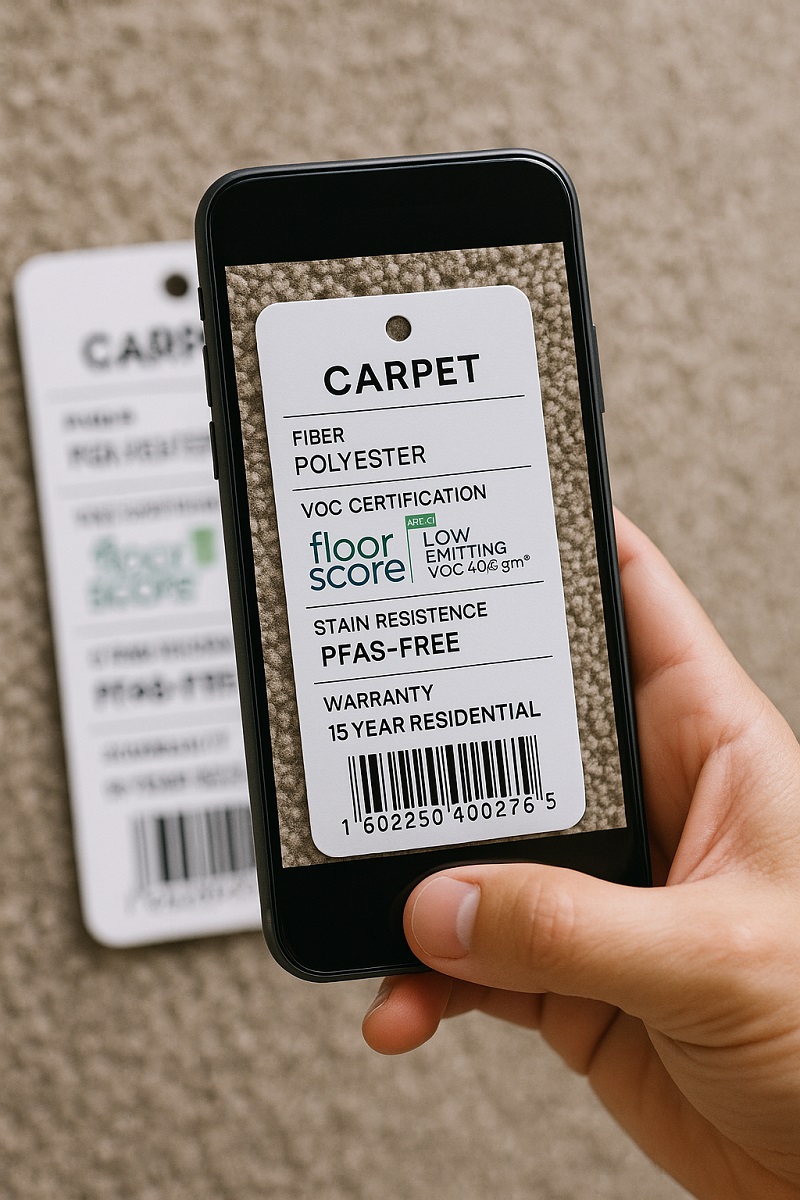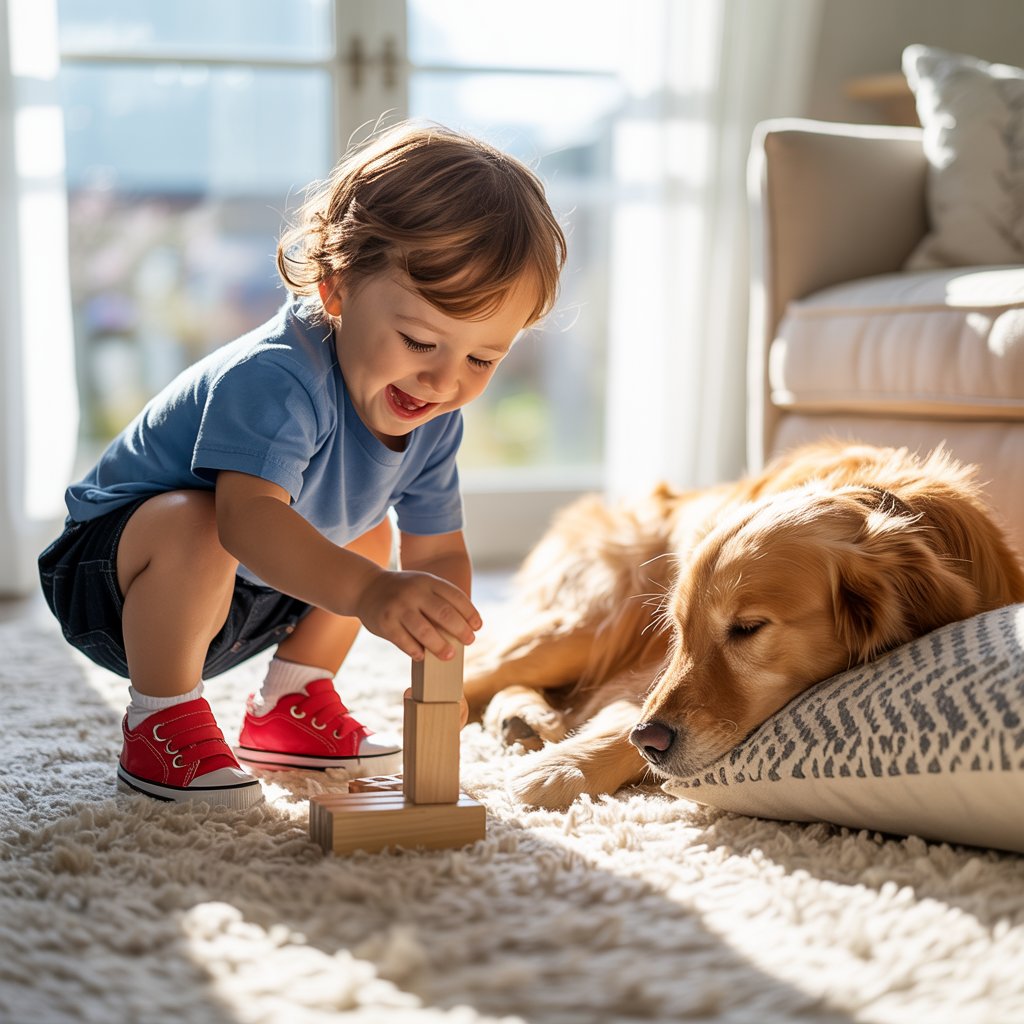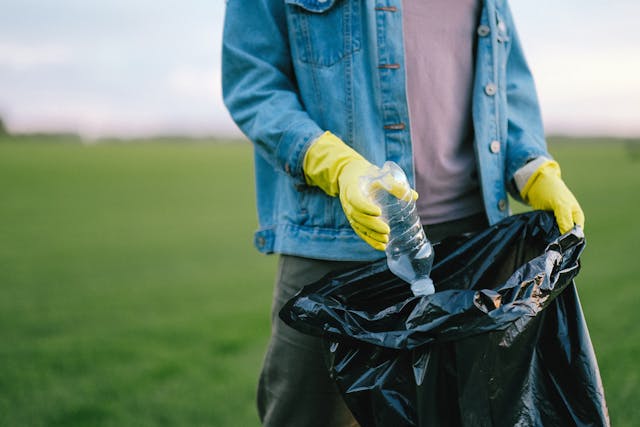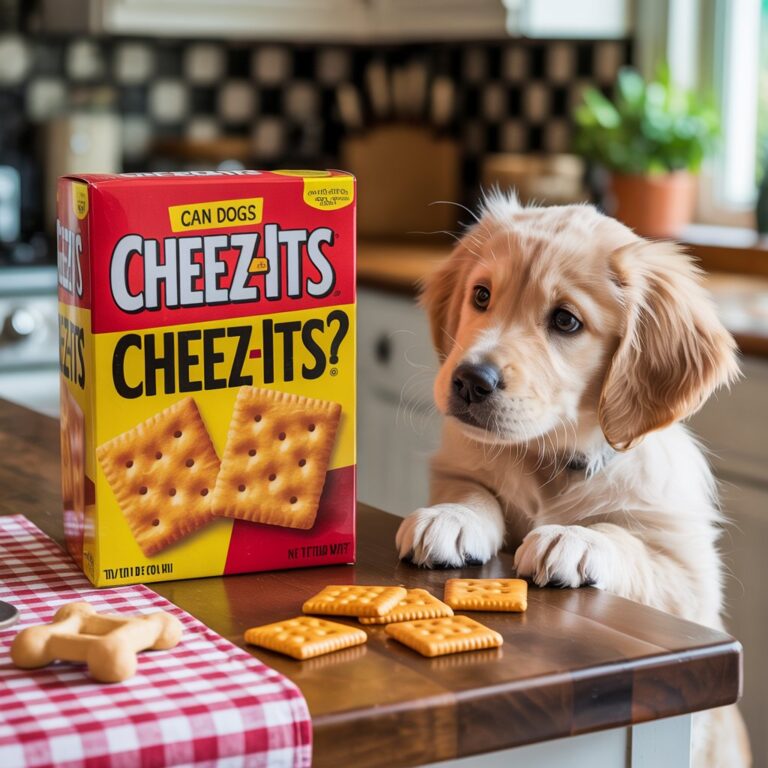What Is Low VOC Carpet?
Low VOC carpet refers to flooring made with materials and adhesives that emit significantly fewer volatile organic compounds (VOCs)—harmful airborne chemicals that can affect indoor air quality. “Low VOC” typically means the carpet has been tested in a controlled chamber and emits less than 0.5 milligrams of total VOCs per cubic meter (mg/m³) within 24 hours, as verified by third-party standards like CRI Green Label Plus or FloorScore. These carpets reduce chemical exposure and are considered safer for babies, pets, allergy sufferers, and anyone with respiratory sensitivities.
Why choose low VOC carpet?
Certified low VOC carpet contains ≤ 50 g/L volatile organic compounds and off-gasses up to 80 percent less than conventional flooring. Independent labels such as CRI Green Label Plus and FloorScore verify safety. The result? Cleaner indoor air, fewer asthma triggers, and a healthier home for kids, pets, and allergy-sensitive adults.
Why Your Carpet Could Be Polluting Your Indoor Air
Americans spend about 90 percent of their time indoors, yet most homeowners never stop to ask what’s floating around in that air. Standard synthetic carpet can release a chemical cocktail—formaldehyde, toluene, benzene—for weeks or even months after installation. At concentrations above roughly 200 µg/m³, these volatile organic compounds (VOCs) are known to irritate eyes, aggravate asthma, and compromise developing immune systems.
Low VOC carpet flips that script. By capping emissions at safe levels and eliminating the worst offenders, manufacturers give sensitive households a flooring option that protects lungs, not burdens them. The rest of this guide unpacks the science, certifications, costs, and practical steps to help you choose confidently.
VOCs 101 – What They Are & Why They Trigger Health Issues
Common Carpet-Related VOCs
- Formaldehyde: Linked to eye, nose, and throat irritation; classified as a human carcinogen by the U.S. National Toxicology Program.
- Styrene & Ethylbenzene: Found in latex backings; associated with headaches and dizziness at high concentrations.
- Toluene & Xylene: Solvents in dyes and adhesives; may impair neurological development in children.
Short- & Long-Term Health Effects
- Immediate reactions: Burning eyes, sore throat, “new-carpet headache.”
- Chronic exposure: Aggravated asthma, eczema flare-ups, endocrine disruption, elevated cancer risk.
- Synergistic impact: Dust mites and VOCs combined can double allergic sensitization rates in kids, according to a 2024 NIH meta-analysis.

What Qualifies as “Low VOC”?
Regulatory Benchmarks
| Standard | Max TVOC (24 h, Small-Scale Chamber) | Notes |
| EPA Indoor airPLUS | 0.5 mg/m³ | Optional spec for ENERGY STAR homes |
| CA 01350 | 0.5 mg/m³ | California’s strict building code reference |
| LEED v4 Low-Emitting Credit | Follows CA 01350 | Contributes up to 3 LEED points |
Third-Party Certifications
| Label | Max TVOC | Retest Frequency | Digital QR Traceability |
| CRI Green Label Plus | ≤ 0.5 mg/m³ | Every 6 months | ✔ |
| FloorScore | ≤ 0.5 mg/m³ | Yearly | ✔ |
| DECLARE (Red List Free) | Zero priority chemicals | n/a | ✔ |
Look for at least one of these logos on carpet samples. A scannable QR code lets you pull the actual lab report—handy proof for building inspectors or allergy-aware clients.

How to Read a Carpet Label Like a Pro
Browsing in-store samples or online listings? Most carpet buyers skip over the small print—but knowing what’s on the label can help you spot low VOC options instantly. Here’s a quick breakdown of what matters:
Common Label Components & What They Mean
| Label Element | What It Tells You | Pro Tip |
| VOC Certification | CRI Green Label Plus, FloorScore, or Declare seal | Must be visible for LEED credits |
| Fiber Type | Nylon, PET, wool, triexta | Look for solution-dyed or undyed natural |
| Backing Material | PVC, SBR latex, jute | PVC-free is best for VOC-sensitive homes |
| Stain/Soil Treatment | PFAS-based or plant-based | “PFAS-free” or “bio-based” preferred |
| Warranty & Wear Rating | Years covered, foot traffic level | Higher warranty usually means better material integrity |
What to Ask the Salesperson
- “Is this FloorScore or Green Label Plus certified?”
- “What kind of padding do you recommend with this that’s also low VOC?”
- “Do you have a safety data sheet (SDS) for this product?”

Why Sensitive Households Benefit
Kids
Children inhale more air per pound of body weight than adults. A 2024 American Academy of Pediatrics cohort study found households that switched to low VOC flooring reduced childhood asthma hospitalizations by 20 percent within six months.
Pets
Many companion animals spend their days belly-down on carpet, nose close to fibers. Veterinarians report fewer upper-airway irritations—especially in short-snout breeds—when VOC levels drop below 200 µg/m³.
Allergy Sufferers
VOCs can bond to household dust, creating “sticky” allergen complexes that linger longer. Reducing VOC emissions means fewer late-night sneezing fits and less reliance on antihistamines.
Pediatrician Quote Call-Out: “Switching to certified low VOC carpet is one of the quickest wins I recommend for families struggling with recurrent wheeze.” — Dr. Marisa Chen, MD, FAAP
Fiber & Construction Science – How Materials Influence Emissions
- Natural Fibers: Untreated wool contains lanolin, a self-extinguishing oil, so it requires fewer flame retardants. It’s naturally low VOC—but can still harbor allergens if not HEPA-vacuumed.
- Recycled PET & Triexta: Solution-dyed polymers embed color during extrusion, eliminating post-dye solvent baths and cutting chemical demand by ≈ 50 percent.
- Backing & Adhesives: Traditional styrene-butadiene rubber (SBR) latex = VOC hotspot. Look for thermoplastic hot-melt tapes or water-based, low-odor adhesives.
- Topical Finishes: Stain-resist treatments can hide PFAS forever-chemicals. Choose “PFAS-free” or “Bio-based repellency” on spec sheets.
Low VOC vs Traditional Carpet
| Factor | Low VOC Carpet | Standard Carpet |
| Initial TVOC (24 h) | ≤ 0.5 mg/m³ | 1.5–3.0 mg/m³ |
| “New-Carpet” Smell Duration | 2–4 days | 10–30 days |
| Avg. Cost (Installed) | $3.50–$8.50 / ft² | $2.50–$6.50 / ft² |
| Allergist Recommendations | ⭐⭐⭐⭐ | ⭐⭐ |
| Certifications | CRI GL+ / FloorScore | Rare |
Yes, you’ll pay about 15–25 percent more up front—but for most households the health dividend outweighs the premium within months.
Top Low VOC Carpet Brands in the USA (2025 Edition)
| Brand & Collection | Fiber | Certs | Recycled Content | Price Range |
| Mohawk Air.o™ | Continuum PET | CRI GL+ | 50 % | $4–$6 / ft² |
| Shaw EcoWorx® (EcoSolution Q Nylon) | Nylon 6 | Cradle-to-Cradle Silver, GL+ | 25 % | $5–$8 |
| Interface NetWorks™ | Nylon Blend | FloorScore, Declare | 55 % | $6–$9 |
| EarthWeave Bio-Floor® | Undyed Wool | None Needed (zero synthetic) | n/a | $7–$12 |
| Nature’s Carpet “Dark Green Line” | Sisal/Wool | GL+, Natural Fibre | n/a | $6–$10 |
Tip: Order samples and perform a quick “sniff test” in a sealed jar—low VOC swatches barely produce detectable odor after 24 hours.
How Climate Affects Carpet VOC Behavior Across the USA
Low VOC carpet doesn’t behave the same way in every environment. Climate plays a surprisingly important role in how long chemicals linger after installation—and what kinds of health concerns are most pressing. Here’s how your local conditions can shape your flooring experience:
Humid Climates (Southeast, Gulf Coast)
- Slower VOC Off-Gassing: High humidity traps VOCs closer to the floor and slows their evaporation.
- Mold Synergy Risk: Moisture can seep into carpet padding and amplify allergy triggers.
- Tip: Prioritize vapor-barrier padding and schedule annual deep cleaning.
- Bonus: Florida, Georgia, and Louisiana offer local tax incentives for green-certified materials.
Dry Climates (Southwest, Mountain West)
- Faster Air Exchange: Dry air helps VOCs dissipate more quickly, especially with good ventilation.
- Padding & Static Risks: Arid air makes some carpets prone to static buildup—favor natural fibers or anti-static treated PET.
- Tip: Wool and jute hold up well; avoid untreated synthetic backings in very dry homes.
️ Cold Climates (Northeast, Upper Midwest)
- Tighter Building Envelopes: Insulated, sealed homes trap air pollutants longer in winter.
- Ventilation Challenges: Opening windows for off-gassing isn’t always practical.
- Tip: Use a HEPA scrubber or MERV-13 HVAC filter during and after installation.
Pro Tip: If you’re installing in a rental, condo, or LEED-registered building, check for regional requirements like CA Section 01350 or New York State Green Residential Guidelines.
Cost, ROI & Funding Pathways
- Health-Care Savings: A Lawrence Berkeley Lab model pegs the annual U.S. cost of sick-building–related respiratory illness at $1–$2 billion. Lower VOC exposure can trim medication expenses and missed workdays.
- Energy & Tax Incentives: Some utilities (e.g., Pacific Gas & Electric) offer $0.25 / ft² rebates on flooring that meets CA 01350. Federal green-building tax deductions (Section 179D) stack for commercial installs.
- Property Value Boost: Realtor.com surveys show “healthy home” listings command a 2–5 percent premium in health-aware metro markets like Portland (OR) and Austin (TX).

Best-Practice Installation Guide
Prep & Ventilation
- Run window fans two days prior.
- Store carpet rolls in the conditioned space 24 hours for acclimation.
Low-VOC Adhesive Alternatives
- Water-based pressure-sensitive glue (< 10 g/L)
- Seaming tape + heat bond (zero VOC)
Post-Install Air-Quality Checklist
| Metric | Target | How to Verify |
| CO₂ | < 800 ppm | Low-cost NDIR monitor |
| TVOC (48 h) | < 250 µg/m³ | Photo-ionization detector or lab test |
| RH | 30–50 % | Hygrometer |
Maintenance Tips to Keep Emissions Low
- Vacuum 2× per week with a sealed HEPA model (ASHRAE 52.2 ≥ 99.97 % @ 0.3 µm).
- Spot-clean using EPA Safer-Choice products—avoid petroleum-based solvents.
- Annual hot-water extraction: ensure detergents leave ≤ 50 ppm VOC residue (ask your cleaner for SDS).
- Control moisture: keep RH below 60 percent; repair slab leaks quickly to prevent mold.
Sustainability & End-of-Life
Low VOC typically equals low impact across the product lifecycle:
- Cradle-to-Cradle Loops: Nylon 6 can be depolymerized back into virgin-quality fiber; Shaw’s Re[TURN] reclaimed 1 billion pounds of carpet since 2006.
- Carbon Footprint: Recycled PET carpet locks ~45 kg CO₂e per 100 ft²—about one-third lower than virgin nylon.
- Take-Back Programs: Carpet America Recovery Effort (CARE) drop-sites exist in 29 states; check www.carpetrecovery.org.
Examples
A Healthy Nursery Remodel (Chicago, IL)
When the Smith family installed Mohawk Air.o in their baby’s room and ventilated for 72 hours, independent lab tests showed formaldehyde levels plummet from 85 ppb to 18 ppb—well below WHO guidelines.
Pet-Friendly Rental Upgrade (Austin, TX)
Property manager Carla M. swapped out 4,000 ft² of 12-year-old conventional carpet for Shaw EcoWorx. Tenant renewals jumped 15 percent, and she recouped the $1.80 / ft² premium through reduced vacancy in 18 months.
Frequently Asked Questions
Q1. Does low VOC mean zero VOC?
No. “Low” typically caps TVOC at ≤ 0.5 mg/m³ after 24 hours. “Zero VOC” (< 5 g/L) exists in some paints but is rare in carpet.
Q2. How long will the “new-carpet smell” last?
With certified low VOC products plus 48–72 hours of cross-ventilation, most homeowners report little to no odor after day 4.
Q3. Will a dehumidifier speed off-gassing?
Lower humidity (< 50 %) accelerates VOC evaporation, so yes—combine it with airflow for best results.
Q4. Can the carpet pad also be low VOC?
Absolutely. Look for polyurethane rebond pads carrying CRI Green Label or a natural felt pad (wool/jute).
Key Takeaways & 5-Point Buyer Checklist
☑ Certification: Seek CRI Green Label Plus or FloorScore.
☑ Fiber & Dye: Opt for solution-dyed PET, triexta, or undyed wool.
☑ Backing: Thermoplastic or bio-based latex; PFAS-free finishes.
☑ Adhesive: Water-based or tape seaming.
☑ Warranty & Take-Back: At least 10 years wear, recycling program included.
Exploring Other Low VOC Flooring Alternatives
Carpet isn’t your only option for low VOC living. If you’re upgrading multiple rooms or want variety across floors, consider these healthy, sustainable choices:
Engineered Hardwood
- VOC Profile: Typically low when pre-finished with water-based or UV-cured coatings.
- Certifications to Look For: GREENGUARD Gold, FloorScore
- Bonus: Excellent resale value and timeless appearance.
Natural Linoleum (Not Vinyl)
- Made From: Linseed oil, jute, wood flour
- VOC Profile: Practically zero when unsealed or factory-cured
- Best Use: Kitchens, mudrooms, play areas
Cork Flooring
- VOC Profile: Naturally antimicrobial; low VOC when sealed with water-based polyurethane
- Feel: Cushioned and warm underfoot—similar to carpet in comfort
Polished Concrete or Concrete Overlays
- VOC Profile: Extremely low with water-based sealers
- Style: Modern, industrial aesthetic
- Caution: Cold and hard; not ideal for kids’ bedrooms without rugs
Conclusion & Next Steps
If your family’s health, your pets’ comfort, or your allergy management plan ranks high on the home-improvement wish list, low VOC carpet is an upgrade that pays back every single day you breathe easier. Combine certified materials with smart installation and routine HEPA maintenance, and you’ll create a living space that’s kinder to both people and planet.




